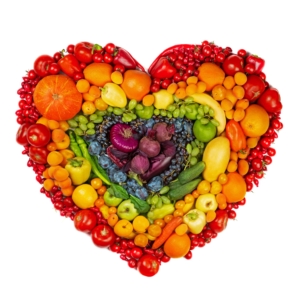The Health Benefits of “Eating the Rainbow” for Seniors
You may have read it in a magazine or seen a social media post about it. But what is “eating the rainbow,” and what color foods are most beneficial for seniors?
“Eating the Rainbow” is a colorful metaphor to help people of all ages eat a more balanced and nutritious diet by filling their plates with various fruits and vegetables of every color. A colorful plate makes your meals more visually appealing (so you’re more likely to eat them!) and ensures you get the essential nutrients required for healthy aging.
How to “Eat the Rainbow”
Our dietary needs change as we age, and prioritizing proper nutrition becomes increasingly important. Here’s how you can add more color to your diet:
Red
Red fruits and vegetables like those in the list below pack a dose of antioxidants such as lycopene and Vitamin C. These nutrients can reduce the risk of heart disease and certain cancers. Add some of these to your plate at every meal:
- tomatoes
- strawberries
- red bell peppers
- beets
- cherries
- apples
- radishes
- raspberries
Orange & Yellow
Orange and yellow foods are rich in beta-carotene and Vitamin A, which are vital for maintaining good eye health, boosting the immune system, and promoting skin health – all great benefits for older adults. But orange foods cover a lot more than carrots and sweet potatoes. Try adding any of these orange & yellow foods to your diet:
- carrots
- sweet potatoes
- oranges
- apricots
- mangoes
- papaya
- cantaloupe
- peaches
- pumpkin
- butternut squash
- orange bell peppers
- yellow bell peppers
- winter squash
- pineapples
- lemons
Green
Green is probably the first color that comes to mind when most people hear the word “vegetable.” If you’re eating lots of greens, you’re probably getting a healthy dose of vitamins K and E. These nutrients help with blood clotting, bone health, and wound healing and also contain antioxidants that can protect cells from damage. While leafy green vegetables are an incredible superfood, if you don’t like leafy greens, there are still many green fruits and vegetables you can enjoy and reap the benefits of:
- avocado
- arugula
- asparagus
- green apples
- pears
- green grapes
- limes
- cucumbers
- spinach
- broccoli
- kiwi
- green beans
- zucchini
- green bell peppers
- green cabbage
White
We often overlook white foods when trying to “eat the rainbow,” but they’re just as important. Packed with nutrients like potassium, fiber, and allicin, white foods can support heart health, digestive health, and immune function. Any of these options will be a great addition to your plate:
- bananas
- cauliflower
- mushrooms
- onions
- garlic
- white fish
- white beans
- potatoes
Tips to Incorporate Colorful Foods into Your Diet:
Start Small: If you don’t usually include many colors in your meals, it’s best to start small. Begin by introducing one or two different colored foods into each meal. You might add some cherry tomatoes to your breakfast omelet, a handful of spinach to your lunchtime sandwich, or a portion of sweet potatoes with your dinner. As this becomes a habit, you can gradually increase the number and variety of colorful foods in your meals.
Experiment with New Foods: Variety is the spice of life – and your diet. To ensure you’re getting a wide range of nutrients, make it a point to change things up. You don’t want your diet to get boring! You might also want to try a new fruit or vegetable each week. Not only will you expand your nutrient intake, but you’ll also add some fresh flavors and textures to your meals… and you might just find a new favorite!
Make Smoothies: Smoothies are a fantastic, delicious, and easy way to consume a variety of colors all at once for a nutrient-packed meal or snack. A green smoothie could include spinach, kiwi, and apples, while a red smoothie might have strawberries, red grapes, and beetroot. The possibilities are endless and limited only by your creativity. You can even pick up a pre-packaged mix of frozen fruits & vegetables at your grocery store for smoothies.
Craft Colorful Salads: Salads offer a fantastic opportunity to mix and match different colored vegetables and fruits. Instead of sticking to the usual lettuce and tomato combo, try crafting vibrant salads with a mix of colors – think purple cabbage, orange carrots, yellow bell peppers, red radishes, and green cucumbers. These colorful salads are not just visually appealing, but they’ll also give your body a huge nutritional boost.
Adopt Seasonal Eating Habits: Each season brings diverse fruits & vegetables with their own unique nutritional profiles. Berries are a summer fruit, and fall is known for its harvest of pumpkins and squash. By eating seasonally, you’re diversifying your diet and consuming produce when it’s at its freshest and most nutritious.
Discover a Vibrant & Colorful Lifestyle at Roland Park Place
Embracing a healthier lifestyle doesn’t have to be a solitary journey. At Roland Park Place, we believe in supporting our residents’ health in every way we can, and we offer a diverse menu filled with colorful, nutrient-rich foods designed to promote optimal health as you age.
Remember, small changes can make a big difference. We encourage you to embrace this colorful approach to nutrition and visit our community today.




